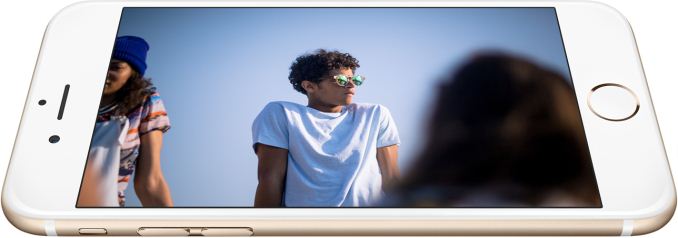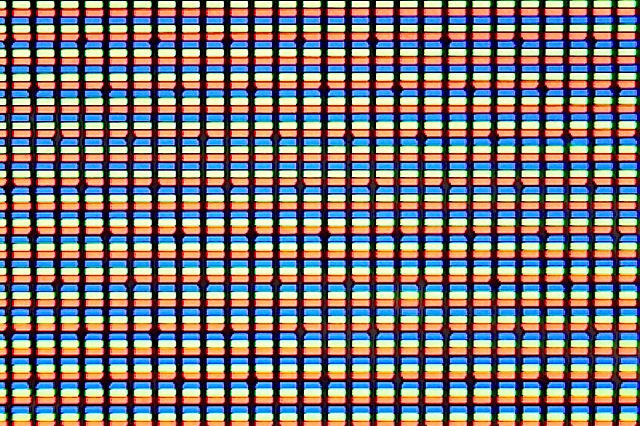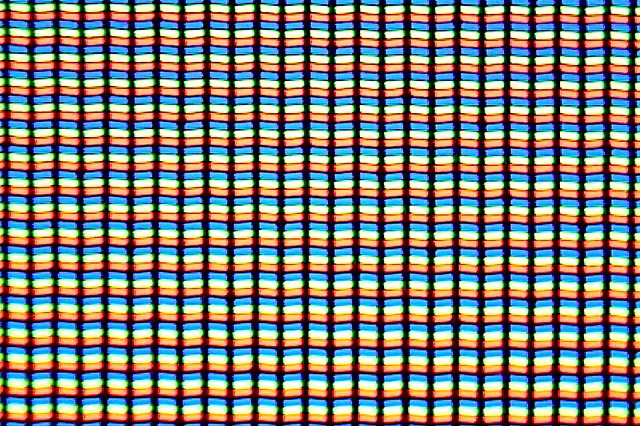Understanding Dual Domain Pixels in the iPhone 6 and iPhone 6 Plus
by Joshua Ho on September 9, 2014 7:20 PM EST- Posted in
- Smartphones
- Apple
- Mobile
- iOS
- iPhone 6
- iPhone 6 Plus

In the launch announcement, Apple announced that their new display had dual domain pixels, which improved viewing angles. Unfortunately they dropped the subject at this, which make for a lot of room for confusion. Anyone that does a cursory analysis through Google will only find references to this type of display in monitors for medical use or similarly technology used by IBM monitors.
However, dual domain pixels are actually not as complicated as they seem. In fact, this is a display technology I remember seeing with the announcement of LG’s AH-IPS technology back in 2011. For those interested in the technical definition, dual domain pixels refers to the fact that the electrodes in the pixels aren’t all aligned. Instead, they’re skewed when viewed from the perspective of the lines defined by the rectangular edges of the display. Because these subpixels are skewed, it’s possible to compensate for uneven lighting that occurs because each individual subpixel is viewed at a different angle, which causes a change in color and a faster fall-off of contrast.

At any rate, this is easiest to explain with a photos. Above, we see the pixel layout of the iPhone 5. This is the standard rows/columns of pixels, and not really news to anyone that knows how displays work. Let's look at a dual domain arrangement next.

Anyone that has tried the HTC One (M7) or One X will probably understand the effect of this change as these phones have had this type of skewed subpixel format to get better viewing angles and less color shifting with changes in viewing angles. This can carry some risk though as black backgrounds may have some color shifting towards purple instead of yellow/blue, which can look strange but is quite subtle in my experience. There's really not too much in the way of disadvantages, so I look forward to seeing how Apple's new displays do in our tests.










30 Comments
View All Comments
KPOM - Saturday, September 13, 2014 - link
The FAQ for the HTC One m7 says it has a dual domain pixel display. And as the article itself notes, medical imaging equipment manufacturers also use that term. Also, Apple never claimed it was unique. Just that they improved viewing angles.JayQ330 - Tuesday, January 20, 2015 - link
I think they were called super LCD (sLCD) & is referred to by apple as "sRGB" & like super LCD it's capable of giving OLED contrast & accurate colors with great contrast, not like oled but close.lukewayne - Wednesday, September 10, 2014 - link
something seems off.. hardly any information to be found about a technology that is in an HTC phone that is over a year old...announced by LG 3+ years ago...B3an - Wednesday, September 10, 2014 - link
It's really sad that no one mentions this until fucking Apple use it. Tech writers are like sheep.Spunjji - Thursday, September 11, 2014 - link
I second that comment. I've seen those pixel arrangements for years and nobody ever bothered mentioning why they existed until now.ianmills - Thursday, September 11, 2014 - link
HAHA whenever I saw that pixel configuration before I just assumed it was becase the guy taking the picture wasn't holding his hand steadyAlexey291 - Monday, September 15, 2014 - link
thanks you made me smile ianmills :3Alexey291 - Monday, September 15, 2014 - link
ah well if apple made it its the last word in tech and anandtech must have an article on it :)bluemeansgo - Tuesday, July 7, 2015 - link
Proof that technology for technology's sake isn't that interesting to the majority. People care about it when Apple uses it because they have a reputation for high quality and making technology usable. We can argue all day about whether that's the case or whether other companies make things just as well... but it's perception and mindshare that's important in this case.In short, articles are written about technology that Apple uses because people care about the technology that Apple uses and the article will get more views.
MarkEduard - Wednesday, September 10, 2014 - link
iPhone 6+ specs:General
2G Network GSM 850 / 900 / 1800 / 1900 - A1522 (GSM), A1522 (CDMA), A1524
CDMA 800 / 1700 / 1900 / 2100 - A1522 (CDMA), A1524
3G Network HSDPA 850 / 900 / 1700 / 1900 / 2100 - A1522 (GSM), A1522 (CDMA), A1524
CDMA2000 1xEV-DO - A1522 (CDMA), A1524
4G Network LTE 700 / 850 / 900 / 1800 / 1900 / 2100 / 2600 / 850 - A1522 (GSM), A1522 (CDMA)
LTE 700 / 800 / 900 / 1800 / 2100 / 2300 / 2600 / 750 / 2500 - A1524
SIM Nano-SIM
Body
Dimensions 158.1 x 77.8 x 7.1 mm (6.22 x 3.06 x 0.28 in)
Weight 172 g (6.07 oz)
- 500 dpi pixel density fingerprint sensor (Touch ID)
Display
Type LED-backlit IPS LCD, capacitive touchscreen, 16M colors
Size 1080 x 1920 pixels, 5.5 inches (~401 ppi pixel density)
Multitouch Yes
Protection Shatter proof glass, oleophobic coating
Sound
Alert types Vibration, proprietary ringtones
Loudspeaker Yes
3.5mm jack Yes
Memory
Card slot No
Internal 16/64/128 GB
Data
GPRS Yes
EDGE Yes
Speed HSDPA, 42 Mbps; HSUPA, 5.76 Mbps; EV-DO Rev. A, up to 3.1 Mbps; LTE, Cat4, 150 Mbps DL, 50 Mbps UL
WLAN Wi-Fi 802.11 a/b/g/n/ac, dual-band, Wi-Fi hotspot
Bluetooth v4.0, A2DP
NFC Yes
USB v2.0
Camera
Primary 8 MP, 3264 x 2448 pixels, optical image stabilization, autofocus, dual-LED (dual tone) flash
Features 1.5µm pixel size, geo-tagging, simultaneous HD video and image recording, touch focus, face and smile detection, image stabilization, panorama, HDR
Video 1080p@60fps, 720p@240fps, optical image stabilization
Secondary 1.2 MP, 720p, burst, HDR
Features
OS iOS 8
Chipset Apple A8
CPU TBA
Sensors Accelerometer, gyro, proximity, compass, barometer
Messaging iMessage, SMS (threaded view), MMS, Email, Push Email
Browser HTML (Safari)
Radio No
GPS Yes, with A-GPS, GLONASS
Java No
Colors Space Gray, Silver, Gold
- Active noise cancellation with dedicated mic
- AirDrop file sharing
- Siri natural language commands and dictation
- iCloud cloud service
- iCloud Keychain
- Twitter and Facebook integration
- TV-out
- Maps
- iBooks PDF reader
- Audio/video player/editor
- Organizer
- Document viewer/editor
- Photo viewer/editor
- Voice memo/dial/command
- Predictive text input
Battery
Non-removable Li-Po battery
Stand-by (2G) / Up to 384 h (3G)
Talk time (2G) / Up to 24 h (3G)
Music play Up to 80 h
Samsung Galaxy Note 4 specs:
General
2G Network GSM 850 / 900 / 1800 / 1900
3G Network HSDPA 850 / 900 / 1900 / 2100
4G Network LTE 800 / 850 / 900 / 1800 / 2100 / 2600
SIM Micro-SIM
Body
Dimensions 153.5 x 78.6 x 8.5 mm (6.04 x 3.09 x 0.33 in)
Weight 176 g (6.21 oz)
- S Pen stylus
- Fingerprint sensor
Display
Type Super AMOLED capacitive touchscreen, 16M colors
Size 1440 x 2560 pixels, 5.7 inches (~515 ppi pixel density)
Multitouch Yes
Protection Corning Gorilla Glass 3
Sound
Alert types Vibration; MP3, WAV ringtones
Loudspeaker Yes
3.5mm jack Yes
Memory
Card slot microSD, up to 128 GB
Internal 32 GB, 3 GB RAM
Data
GPRS Yes
EDGE Yes
Speed HSDPA, 42 Mbps; HSUPA; LTE, Cat4 (N910C), Cat6 (N910S), 50 Mbps UL, 300 Mbps (N910S), 150 Mbps (N910C) DL
WLAN Wi-Fi 802.11 a/b/g/n/ac, dual-band, Wi-Fi Direct, DLNA, Wi-Fi hotspot
Bluetooth v4.1, A2DP, EDR, LE
NFC Yes
Infrared port Yes
USB microUSB v2.0 (MHL 3), USB Host, USB On-the-go
Camera
Primary 16 MP, 3456 x 4608 pixels, LED flash
Features Autofocus, Touch to focus, Manual focus, Digital image stabilization, Optical image stabilization, Face detection, Smile detection, Exposure compensation, ISO control, White balance presets, Burst mode, Digital zoom, Geo tagging, High Dynamic Range mode (HDR), Panorama, Macro mode, Night mode, Scenes, Effects, Self-timer, Voice activation, Dual Shot, Simultaneous HD video and image recording, geo-tagging
Video 3840x2160 (4K) (30 fps), 1920x1080 (1080p HD) (60 fps)
Features:
Optical image stabilization, Continuous autofocus, Picture-taking during video recording.
Secondary 3.7 MP, 1080p@30fps,
Features
OS Android OS, v4.4.4 (KitKat)
Chipset Qualcomm Snapdragon 805 (SM-N910S)
Exynos 5433 (SM-N910C)
CPU Quad-core 2.7 GHz Krait 450 (SM-N910S)
Quad-core 1.3 GHz Cortex-A53 & 1.9GHz quad-core Cortex-A57 (SM-N910C)
GPU Adreno 420 (SM-N910S)
Mali-T760 (SM-N910C)
Sensors Accelerometer, gyro, proximity, compass, barometer, gesture, UV, heart rate, SpO2
Messaging SMS(threaded view), MMS, Email, Push Mail, IM
Browser HTML5
Radio TBC
GPS Yes, with A-GPS, GLONASS, Beidou
Java Yes, via Java MIDP emulator
Colors Frosted white, Charcoal black, Bronze Gold, Blossom Pink
- ANT+ support
- S-Voice natural language commands and dictation
- Air gestures
- Dropbox (50 GB cloud storage)
- SNS integration
- Active noise cancellation with dedicated mic
- TV-out (via MHL A/V link)
- MP4/DivX/XviD/WMV/H.264/H.263 player
- MP3/WAV/eAAC+/AC3/FLAC player
- Organizer
- Photo/video editor
- Document viewer(Word, Excel, PowerPoint, PDF)
- Google Search, Maps, Gmail,
YouTube, Calendar, Google Talk, Picasa
- Voice memo/dial/commands
- Predictive text input (Swype)
Battery
3,220 mAh battery
now CHOOSE!